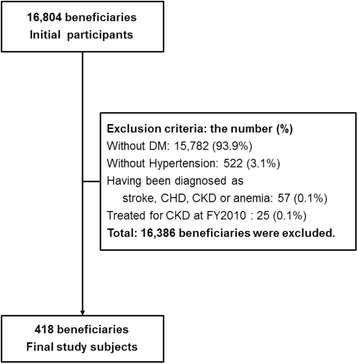Does antihypertensive treatment with renin-angiotensin system inhibitors prevent the development of diabetic kidney disease?
- PMID: 26362195
- PMCID: PMC4567802
- DOI: 10.1186/s40360-015-0024-y
Does antihypertensive treatment with renin-angiotensin system inhibitors prevent the development of diabetic kidney disease?
Abstract
Background: Diabetic kidney disease (DKD) is the leading cause of end-stage renal disease worldwide. Renin-angiotensin system (RAS) inhibitors are the first-line treatment for diabetic patients with hypertension. However, whether RAS inhibitors prevent the development of DKD remains controversial. We conducted a retrospective cohort study quantifying the preventive effect of antihypertensive treatment with RAS inhibitors on DKD, using data from specific health check-ups and health insurance claims.
Methods: The study subjects were 418 patients with diabetes and hypertension, drawn from health insurance societies located in Fukuoka and Shizuoka prefectures in Japan. The subjects were divided into three groups, according to the type of antihypertensive treatment they received. They were then compared in terms of the development of DKD, using the diagnostic codes from ICD-10.
Results: Thirty subjects (6.2%) developed DKD during the study period between April 2011 and September 2013. RAS inhibitor treated group showed a significantly lower risk of DKD [adjusted odds ratio (AOR) = 0.35; 95% confidential interval (CI): 0.16-0.76] compared with the no treatment group.
Conclusion: We conclude that antihypertensive treatment with RAS inhibitors is potentially useful for preventing the development of DKD.
Figures
References
Publication types
MeSH terms
Substances
LinkOut - more resources
Full Text Sources
Other Literature Sources
Medical
Miscellaneous


